It’s a Moment of Racial Reckoning. Is It Also a Moment of Real Change?
Reflecting on their personal encounters with injustice, Brandeisians express outrage, fear and hope for a better future.
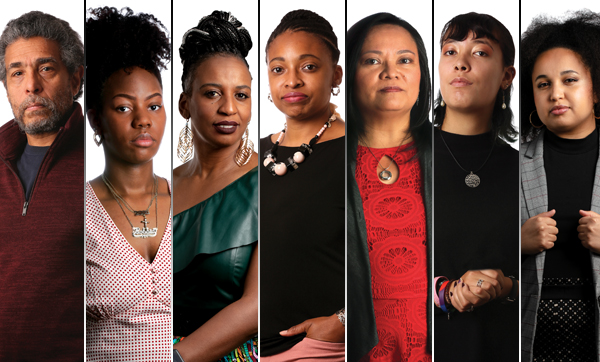
Over the past few months, Brandeis Magazine invited a small group of students, alumni, faculty and staff of color to write about a personal experience that speaks to the moment of racial reckoning the United States is undergoing.
We asked these individuals to consider what the encounter signified and whether it stood for something larger. We also wondered what they were feeling and thinking as the nation grapples with its history, and ongoing social and economic inequities. The accounts they sent us shed light on how even the most ordinary experiences — walking down the street, driving to track practice, taking the subway — can spiral from the mundane into the malign when racism intervenes.
Our respondents describe anger, frustration, anxiety and fear, but also a fragile hope that our national reflection on anti-Black racism might signal a turning point in the struggle to overcome systemic injustice in America.
To learn more about Brandeis’ initiatives to combat anti-Black racism on campus, read President Ron Liebowitz’s letter in this issue.
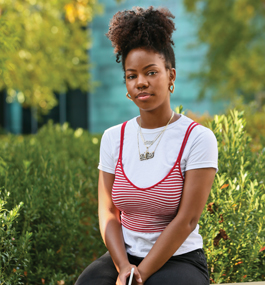
Mike Lovett
page 2 of 8
‘The Starkest Consequences of Being Black’
By Bobbie Norman ’22
I was never so Black until I came to Brandeis.
Growing up, I associated the word “Black” with a warm hug or the sweet taste of dark, ripe fruit. But at Brandeis, I experienced my identity reflected through eyes that saw Black as “poor,” “uncultured” and, sometimes, “threatening.”
My roommate accused me of stealing. Professors avoided saying certain words, such as “slavery,” in my presence. Students asked me to describe “the ghetto” as if it were a foreign country. They called me by the names of other Black students on campus, even after being corrected multiple times. They asked whether I could afford the name-brand clothes I wore. They felt entitled to say or sing racial slurs. They avoided me at first, only to be visibly relieved later when I was nice to them once they talked to me. They asked me to answer questions as a representative of my race.
I learned to accept this other truth about Blackness that was defined and imposed on me by non-Black people.
I am never not Black. One night in Brooklyn, I was walking with my friend Al after a graduation party. A tan car drove alongside us, going the wrong way down a one-way street. The driver and passenger were slouched down in their seats, peering at us through a partially open tinted side window. I told myself not to worry, they weren’t looking for me.
We sighed in relief as the car passed us. Then it suddenly reversed direction. Two cops hopped out. “Put up your hands,” they told Al.
Everything about Al is average: his height, build, hair and voice. The only thing that isn’t average is the way his white teeth shine against his black skin; this contrast makes him more beautiful than average.
The officer who approached Al was smaller than him. He growled the command once more. Al obeyed, slowly pulling his hands out of his pockets, fingers still latched around his phone. I was scared the officers would mistake his phone for a gun. Would I have to tell Al’s mother I was with him when he was killed by the police? Going against every natural response, I remained quiet and still. I did not want to provoke the officers.
The cop patted Al down. Al’s face twisted in disgust as the cop’s hands touched him all over his body. The cop told him to “fix his face,” ranting about how Black kids in this neighborhood at this time of night could only be up to trouble. In that moment, something shifted in me, and it was as if I were seeing Al for the first time: a big, dark, scary hoodlum who wore excessive jewelry, pants that were too low and a hoodie that was intimidating.
I realized it didn’t matter that I was a Brandeis student or that Al spent most of his time wearing a suit in his business-school classes downtown. We could not change our clothes, or alter our way of speaking, or earn enough degrees in a white supremacist society to save ourselves from the starkest consequences of being Black. Brooklyn native Bobbie Norman is majoring in environmental studies.
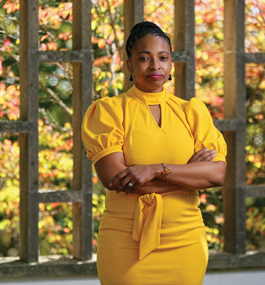
Mike Lovett
page 3 of 8
‘We Will Continue To Affirm This Truth’
By Erika Smith, Heller PhD’15
I was a 19-year-old student at one of the top-ranked colleges in the U.S., where I had a prestigious leadership scholarship. Two Black male teammates and I were in my 1982 Datsun, which my friends affectionately called the Silver Bullet, headed for track practice at the athletic facility. As I parked outside the facility, I noticed a police car behind us.
My companions gave me “the talk” at lightning speed: “Keep your hands on the wheel; don’t reach for your registration or license; he already has his hand on his gun.” When the officer walked up to my window, he told me he had been following me for a few blocks because I had made “a wide right turn.” There had been neither a siren nor flashing lights.
The officer asked to see my license and registration. I carefully retrieved and handed over both. After he looked at them, he questioned the registration.
My father, who had immigrated to the U.S. at a young age, worked hard to provide for his family. Impressed with the reliability of his own 1981 Datsun (which my brothers and I jokingly named the Rust Bucket), he bought me my car for $500. It was registered in his name.
Fairly undone but managing to hold it together, I explained this to the officer and watched him go back to his cruiser. When he returned, he handed me my license and registration, and told me to drive more carefully. I had a visceral understanding that this encounter could have gone a very different way.
My friends and I went on to practice. We didn’t discuss what had happened. It simply became part of a shared understanding of what it means to be Black. Most important, we never told university administrators or town officials about it.
We will never be able to quantify the impact of experiences like this. Yet, as a university administrator myself now, I hope all of us understand that we are responsible for accounting for this trauma in students’ lives and for supporting students accordingly.
As the world reacts to the murders of George Floyd, Breonna Taylor, Tony McDade and Ahmaud Arbery, we are taking a collective moment to pause and reflect deeply. I wonder, though, would white people have paid as much attention to these acts and what they represent had the pandemic not narrowed the usual distractions in our lives?
No Black person — not an honors student, not a student at one of the top colleges in the country, not a graduate of Harvard, not a dean with a Brandeis PhD — is exempt from racism. We are routinely told in large and small ways that our lives, dignity and freedom don’t matter.
They do. And we will continue to affirm this truth.
Erika Smith is dean of academic services at Brandeis and an affiliated researcher with the Heller School’s Institute for Child, Youth and Family Policy.
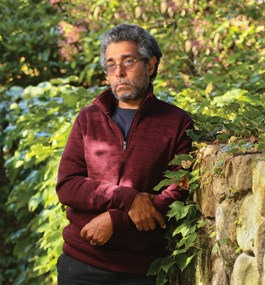
Mike Lovett
page 4 of 8
‘Not Again!’
By Bil Mooney-McCoy ’78
It was just another Tuesday evening. When you’re Black and living in the United States, you don’t get a text: “Racial Incident Imminent! Prepare Yourself!” At least, I didn’t get that text.
I boarded a Red Line train at Harvard Station. As I sat down, I noticed a 20-something white man across from me stretched out in a deep sleep, maybe drunk. For a veteran subway rider like me, this is nothing unusual. I took out my computer and forgot about him.
Several stations later, I looked up from my screen, and there it was. The young man was sitting up and staring at me. He was smiling, but it was an angry, hate-filled smile. And he was giving me the finger.
Time froze.
My first reaction was incredulity. Fear followed, commingled with anger. I decided to go back to nerding out on my computer. A few minutes later, the guy went back to sleep. I didn’t notice when he got off the train.
I’ve replayed the incident in my head many times. Was it definitely a racially based aggression? Maybe the guy hates people who wear glasses, or use computers, or carry a blue backpack. No, I certainly experienced the incident as racial. And he certainly would have known that would be my assumption, and he was OK with that.
Truly, it infuriates me that someone a third of my age took pleasure in insulting a stranger just for being Black. From now on, I will probably feel anxiety whenever I board a Harvard Station train. But the strongest residual emotion I have is crushing disappointment, combined with a reality-based sense of déjà vu: Dammit! Not again!
Hostile racial incidents were once routine for me. In Boston, from middle school until early adulthood, it was commonplace for white strangers to hurl ethnic profanity-laden slurs, to throw objects, to threaten bodily harm. At 10, I was accosted by a schoolmate with a knife. On two occasions, I was punched in the face. But equally painful was when someone would catch my eye and quietly say, “Hello, nigger.” I now describe these occurrences as domestic terrorism.
Sometime in the mid-1980s, the incidents stopped. Gradually, the gnawing anxiety that at any moment I could get jumped or N-bombed faded. I no longer worried about going into certain neighborhoods. I stopped being afraid. This lasted for about 30 years.
Then someone pressed the rewind button.
Black friends started sharing racial aggression stories that felt familiar. I read about unarmed Blacks being killed by law enforcement and took note of emboldened national expressions of thinly veiled bigotry. “Driving while Black” entered the American lexicon. And then I took that subway ride.
Now I feel profound sadness. Not for me, but for my kids, for my 10-year-old granddaughter. I am heartbroken they are likely to experience random onslaughts of hatred like I have. Not again!
This is not a feel-good, neatly resolved story. But I will close with a word of hope. I am grateful that so many have been moved from apathy and ignorance by the spectacle of a slow-motion lynching in Minneapolis. I am grateful an Op-Ed I wrote about racism for The Boston Globe has led to expressions of empathy, sadness and outrage (particularly from Brandeis classmates). I am grateful Brandeis Magazine asked me to write this. These things give me hope.
This is what I will try to remember the next time I get on a train at Harvard Station on a Tuesday evening.
Bil Mooney-McCoy is director of worship at Gordon College, in Wenham, Massachusetts, and teaches private music lessons.
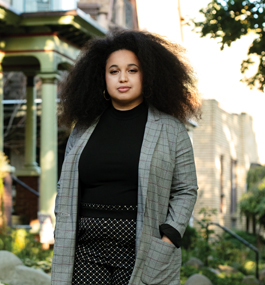
Jörg Meyer
page 5 of 8
‘All of Me Is Grieving’
By Kaamila Mohamed ’11
I had not been on Facebook for several years. I had moved a few times, faced health challenges, began and left graduate school, and I preferred to avoid the inevitable pileup of unanswered messages and notifications.
And then the pandemic began. No longer going into the office, I developed a habit of spending way too much time in bed reading the news. Watching the spread of COVID-19, observing the incompetence and downright cruelty of so-called leaders, I could almost feel the excess cortisol flowing through me.
When I read about the death of Ahmaud Arbery, my heart clenched, and my breath stopped. I added his name to a long list of names that had been growing over the years: Trayvon Martin, Eric Garner, Michael Brown. The twin scourges of 2020 — a pandemic and the mounting murders of Black people — continued with the deaths of Breonna Taylor and George Floyd. I could not reduce the intensity of my heart rate.
I was desperate for connection, even if it meant going to a protest alone. Living in a newish city, away from the Black community I’d previously relied on to tell me about events, I decided to reactivate Facebook.
One of the first images I saw was a woman I went to high school with, her face framed by a Black Lives Matter message. Back in high school, she told me that in Christianity dark skin was the mark of a sinful lineage, a belief used throughout history to justify the slave trade. As one of only four Black students in my class, I had to deal with blatantly racist attitudes like this.
I couldn’t reconcile my memory with this woman’s public BLM messaging. I had similar moments as I spent more time on social media. Statuses and comments proclaimed support for Black lives and against racism. People from high school, college and work checked in with me. Again and again, I remembered them as individuals who had harmed me with their racist attitudes.
I fantasized about commenting on their BLM posts: “In high school, you said X to me.” “Aren’t you the person who did Y when we were at college?” “Hey there, old co-worker who said Z.” Instead, I scrolled by the faces and names of people who have been part of my lifelong racial trauma. As Black people, sometimes we are killed quickly. And sometimes we are killed slowly, chipped away at little by little.
Part of me feels flashes of hope. Maybe this is a moment of real change. Other times, cynicism sinks in. Will non-Black people still care as much when the hashtags have faded and the protests are over? Will they speak up when anti-racism isn’t trending, when it’s uncomfortable, when it’s inconvenient, when it’s risky?
All of me is grieving, for those who have been slain, for the way racism has impacted the life of every Black person I know and for all it has taken from me. I wonder if the faces I scroll by remember the harm they have caused, if they remember the past like I do.
Kaamila Mohamed is a Philadelphia-based psychotherapist, facilitator, speaker and arts practitioner engaged in community building and healing, particularly within queer, Muslim and people-of-color communities.

Mike Lovett
page 6 of 8
‘How Can We Change If We Don’t Acknowledge the True Story?’
By Grace Talusan
As the wife of a Black American man, I’ve long been aware of racism’s field of weeds, how it spreads seeds everywhere the wind blows. Small acts of racism can ruin an otherwise pleasant day. Systemic racism is even more insidious. It’s caused generations of my husband’s family to experience chronic underemployment, higher rates of incarceration and shortened life expectancies.
Although my family, who were immigrants from the Philippines, experienced racial microaggressions, I can see how we were perceived as “good” immigrants. Our neighbors would wonder aloud why all minorities weren’t like us, without remembering how different people’s histories are in this country.
This current moment does feel different from other times I’ve seen protest arise in response to racial injustice. Recent polls show evidence of increased public support for the Black Lives Matter movement, especially from white people. I appreciate this renewed awareness of racism. We cannot transform our society without all of its actors participating, especially those who benefit the most from its systems.
For many years, my husband and I have lived a few blocks from the Royall House and Slave Quarters, in Medford, Massachusetts. At one time, this was the home of the state’s largest slaveholding household. Between 1737-81, 60 enslaved people milked the cows, grew and prepared the food, and did the laundry for the Royall family.
When I toured the museum, now the only standing slave quarters in all of New England, the guide pointed out the contrast between the relatively good condition of the stairs the Royall family used and the worn service stairs, out of sight in the back of the house, the enslaved people traversed day and night in service to the Royalls.
The guide let us touch the fabrics that people wore back then. The enslaved women dressed in coarse materials. The Royall women’s dresses rustled when they moved about the house, so that those who served them could hear their movements. How soft this sound must have been, except to those forced to tune into it.
This is why places like the Royall House are so important. They preserve what is so often diminished in, even erased from, the national narrative. How can we change if we don’t acknowledge the true story?
A few blocks from the Royall House is a yellow brick building, the Medford Veterans of Foreign Wars post. An All Lives Matter banner hung on its front facade for years. I didn’t like the banner but respected the organization’s right to display it. Then I noticed that the banner stayed up when the building was being used as a polling place. I did not feel comfortable casting my ballot there, in the shadow of an obvious political sign, and voted early at city hall as a workaround. I also voiced my concerns. The VFW refused to cover or remove the sign on the days the building served as a polling place. Eventually, the city council voted to move the polling site elsewhere.
Recently, I noticed the All Lives Matter banner had been taken down. I don’t know when that happened, but, if it’s an indication this moment of racial reckoning is different, I take its absence as a hopeful sign.
Grace Talusan is the university’s Fannie Hurst Writer-in-Residence and author of the memoir “The Body Papers.”

Mike Lovett
page 7 of 8
‘The People With Whom I Have Found Community’
By Aviva Davis ’21
In the fourth grade, a classmate told me I didn’t look Jewish. At the time, I laughed it off. “Microaggression” was not yet in my vocabulary, and I didn’t know how problematic it is for someone to believe that Jews look a certain way.
Because people carry internal biases about Jews and BIPOC individuals, it’s important for young Jews of color to learn about themselves and the intersections between their identities.
That fourth-grade interaction became a catalyst for me to arm myself with knowledge, to prepare for other situations in which someone would question my identities. With the help of my mother, also a Jewish woman of color, and a Jewish diversity organization called Be’Chol Lashon, I am more informed than ever.
I write articles and speak about my experiences to explain what it means to be a Black Jew in a world where the Black and Jewish communities are seen as mutually exclusive. Sometimes people tell me that my experiences aren’t valid or that I am finding reasons to play the victim. I used to try to interact with these people, hoping a one-on-one conversation would change their minds. Often it only fueled their anger.
Eventually, I realized I was wasting energy on these individuals. I also realized many readers of my pieces and viewers of my recorded dialogues genuinely wanted to learn. These are the people with whom I have found community. They are the ones giving me hope that, someday, Jews of all colors will be able to coexist in peace and not face oppression from non-BIPOC individuals. Whether it is a mother who wants to know what books she might read to her biracial Jewish children or a reader who doesn’t know what “microaggression” means, I am honored these people turn to me for help.
I know how to stand up for myself and for other Jews of color now. I have thicker skin that can deflect words of hate. I have a strong support system that is there for me on every step of my journey. I am proud of and strong in my identity as a Black, queer, Jewish woman, and I will fight for equity and against ignorance for as long as I am able.
Oakland, California, native Aviva Davis is majoring in psychology with a double minor in Creativity, the Arts and Social Transformation, and Hispanic studies.

Jörg Meyer
page 8 of 8
‘We Must Get in Good Trouble’
By Janice Johnson Dias ’94
As America reckons with its history of racial injustice, it’s unclear to me whether we are ready to build anew. I’m not sure whether we can act as a united nation.
So far, our national responses to the largest public health crisis in modern times have ignored the science, balked at facts, refused to consider others’ well-being and rebelled against precautionary measures. We have treated efforts to abate the spread of COVID-19 as a personal attack on our civil liberties.
We treat the fight for racial justice in much the same way.
In July, while I was making edits to a book I’m writing, my daughter and husband came in to tell me an unknown woman and her children were hosting a picnic on our lawn.
Yes, you read that correctly: A mother felt emboldened to host a feast on our lawn in the middle of a pandemic. This mom, even in a high-income community like mine, did not stop to consider my family’s health or the boundaries of our property.
My husband and daughter took pictures and videos as evidence, then my husband put on his hazmat suit, gloves and mask, and turned on the sprinkler system, which encouraged her to leave. They asked me to stay inside the house as she was departing because they were concerned I might confront her. They were correct. I certainly would have asked her why she thought hosting a gathering in our yard was appropriate. I might even have turned the water directly on her instead of the lawn.
Luckily, calmer heads prevailed. My husband did what most of us who are Black in America do when confronted with the unjust actions of white folk — we gather evidence, because we know we may not be believed. My daughter did what far too many of us do — watch and call attention, hoping someone will act. I, conversely, confront racists. Sometimes the process is not pretty.
My family is one of a few Black families in a mostly white neighborhood. In light of this, my husband and daughter responded reasonably and understandably. However, if we have learned anything from U.S. history and this public health moment, we know that congeniality will not move us forward. We need more-brazen actions to advance public health and achieve racial justice. We must question, educate and confront.
We must get in good trouble, especially on our lawns.
Janice Johnson Dias is president of GrassROOTS Community Foundation, a public health and social action organization in West Orange, New Jersey, that works to mobilize communities and offset economic disadvantage.
